As many of you know, Spectrum 20 is the final volume that Cathy and I will be editing and the last to be published by Underwood Books. As detailed in Cathy’s “Chairman’s Message,” John Fleskes has taken on the reins as both editor and publisher beginning with Spectrum 21 and will be conducting the annual competition. We sincerely hope the creative community will support John with the same enthusiasm that you supported us over the past 20 years as he takes Spectrum into the future.
In my final Spectrum essay, “Hello, I Must Be Going,” I talk a bit about the whys and hows of the annual and competition through the years, discuss some of the challenges we faced, and address some of the concerns I have about our community moving forward. I’m not going to recount them here: if you’re interested, grab a copy of the book and read what I have to say.
Just for fun what I’m going to do today is tell a few stories about what has gone on through the years. So here we go.
If you own first editions of Spectrum 1 and Spectrum 2 you’ll notice that reprints of #1 have a different bacover and the reprint of #2 a different front and back: why? Well, we had used a Joe DeVito Wonder Woman painting on the back of #1 and a Rick Berry portrait of Neil Gaiman’s Death on #2, both of which are owned by DC Comics. DC (very understandably) was concerned that their characters appearing on the covers of books that they didn’t publish might cause confusion and asked that future editions not include them. We were happy to comply and that led to a very positive and long-lasting relationship with DC. And, of course, they weren’t the only company who wanted to support Spectrum but who also wanted to ensure that their copyrights were observed in the process, including Marvel, Disney, Wizards of the Coast, 20th Century Fox, Lucasfilm Ltd., and many others…and, of course, we happily cooperated. It was the willingness of these corporations to support the artists that helped Spectrum achieve the reputation that it enjoys. Oh, and we changed the bacover of #2—which was by Ezra Tucker—not because we were asked, but only because we didn’t have a copy of the art to use when the new covers were being put together. We had shot Ezra’s art from a transparency (those were pre-digital days) and couldn’t get it back in time to use it for the reprint; software had changed, too, and some copy had to change so the old film couldn’t be used. Today, it’d be easier.
Well, we didn’t, but someone else almost did during one of the Spectrum judgings. We were using an Embassy Suites at the time, one of those 30 story hotels where the rooms circle a floor to sky courtyard. The jury was taking a break at a table in the courtyard while we were resetting the ballroom we’d rented for the next round of voting and someone from one of the upper floors hurled a full can of Coke over the balcony. Like a missile it plummeted toward the courtyard and barely missed Michael’s head by a scant few inches: it exploded at his feet when it struck the floor. Michael seemed rather nonchalant about the incident…but I had a cow. The following year we moved to the Hyatt Regency: it was safer.
As I mentioned above, we had to reset the room we rented for judging multiple times through the day of the event so that every entered art could be viewed and voted on (unlike many other competitions, we never prescreened the art: the jury saw everything). The resets provided a good opportunity for the judges to stretch their legs, get something to drink, hit the head, or have a snack. So imagine our shock as we went to call them back for another round of voting…and they’re gone! Five jurors: vanished! Crap! We only had the room for a finite period and after the voting the jury was still going to have to debate the awards in each category. So we franticly started searching high and low and…we finally found them. The Pussycat Dolls had arrived earlier in the morning for a show that night and were rehearsing their routine (with relatively little on) in one of the ballrooms on another floor and the judges were all crammed in the doorway watching, undoubtedly out of professional interest and with plans to give their suggestions on how to improve their performance. With the aid of a whip, chair, and revolver we were able to drive them—sullenly, I admit—back to the voting.
Another jury had disappeared during a previous judging, but it was a little easier to track them down: Rick Berry had taken them all back to his room to sample a single malt scotch he had brought to share. With his fellow jurors, not with us. The bum.
Not everyone gets into Spectrum: that’s always been explained from the outset. You have to get a simple majority of votes by the jury to be accepted; I’ve always explained that not getting work accepted isn’t a criticism. It isn’t personal. It’s simply a reflection of a jury’s outlook: a different jury, a different day, the results might be completely different or completely the same. You never know unless you take a shot. Not everyone thinks that way: some have felt that not having work selected is an insult…and we’ve heard about it. One in particular stood out. We received an envelope from an entrant unhappy that his work hadn’t been selected for inclusion in the annual and expressed that unhappiness by filling the envelope with explicit photos of people being, ah, orally serviced and scrawled across them with a Sharpie was the message, “THIS IS WHAT YOUR JURY WAS DOING INSTEAD OF LOOKING AT MY ART!!!” So of course we shared it with the judges: Kelly Seda asked, “How’d he know?” Justin Sweet just smirked his Justin smirk and flexed his arms that are bigger than my head. Frank Cho said, “This one looks like Daren!” which made Daren Bader groan loudly, “FRANK!!!” The funniest part of the story is that the entrant was kind enough to have written his name and address on the envelope, so I looked up his phone number and called him. Imagine his surprise.
There are only three artists in Spectrum‘s history that made it into 19 volumes of the book: Brom, Scott Gustafson, and James Gurney. It had been like that for a number of years and we started joking that Spectrum was Thunderdome for Scott, Jim, and Brom: three artists enter, one artist leaves. Except all three kept making it through the jury process year after year. But now there are only two artists whose work has been selected for inclusion in all twenty editions of Spectrum. With volume #20, Brom and Scott emerged as the Last Artists Standing. (Brom says he put a hex on Jim, but I don’t think he really has Gurney’s fingernail clippings attached to a voodoo doll. I don’t. Really.) What will happen with #21 is anyone’s guess.
I’m a little surprised that no one has noticed this, so I thought I’d mention it. One of the primary inspirations for Spectrum was the exhibit at the Society of Illustrators in the 1980s organized by Wayne Barlowe and Michael Whelan. Michael and I had talked early on about the need of some sort of fantasy art annual and, after Spectrum got rolling, we relied on him as an advisor and as a juror on multiple occasions. I respect the hell out of Michael: always have, always will. So through the years, if he had an accepted piece that was in the “Unpublished” category, Cathy and I made a deliberate attempt to close the book with one of Michael’s artworks as a quiet show of the respect we felt: it didn’t happen every year, but…frequently. Go back and take a look.
Do I have more stories? Oh sure I do. Like how Brom’s prank almost got me in a fight with Harlan Ellison or about the year we almost lost a quarter of the entries after the judging, stuff like that. If you want to hear them, let me know.


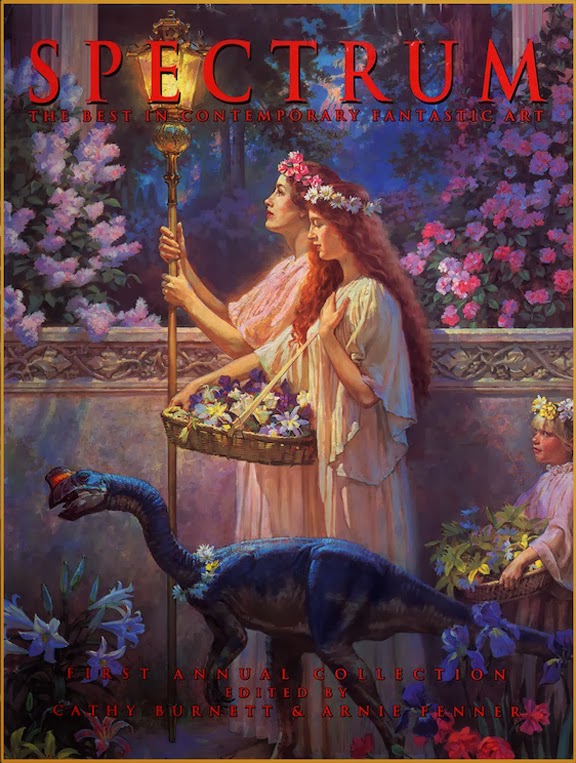
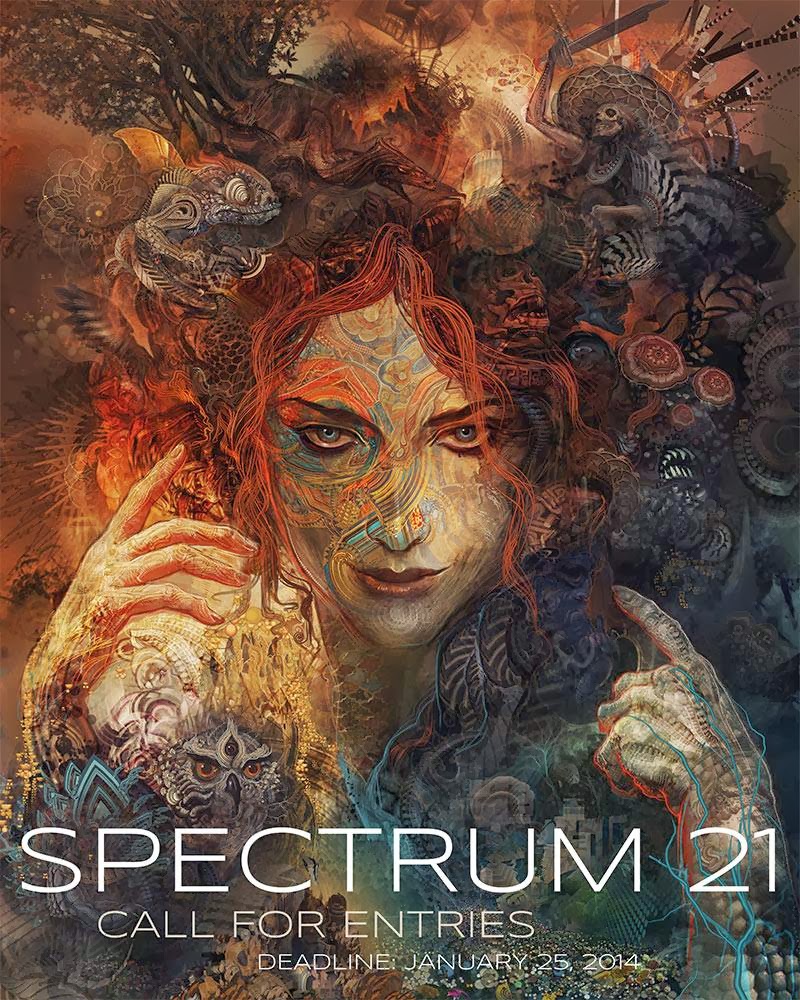
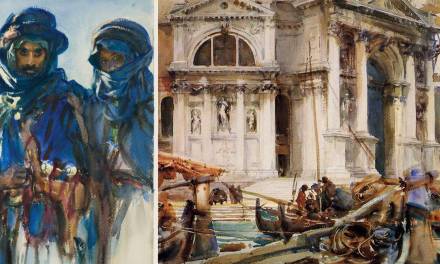
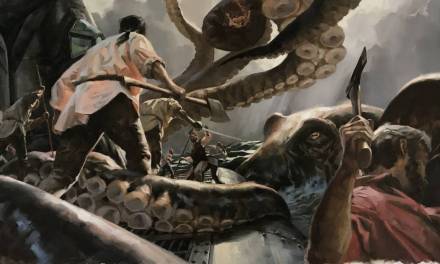

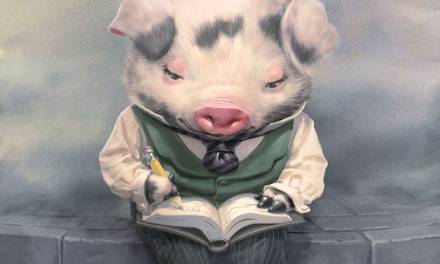

Oh please, do go on! The ins and outs of publishing a work of this magnitude always have some amazing behind the scenes stories. It would be wonderful to hear more of them.
“Do you know how often we get a Judge up in Embassy Suites?”
“Well, you got one now…”
Stories are the best. I've told you before I think that a book of Spectrum narratives is a must. Illustrated by Spectrumites of course.
Yep, let me add my voice to what will be many saying 'YES!' to more stories! Great post Arnie!
More stories, please.
I KNEW those Michael Whelans weren't a coincidence! Some people noticed Arnie. I always smiled when I saw them. Saving the “best for last”.
waiting for Spectrum Stories Part 2…
You realize that folks looking to enter the Spectrum competition can draw inspiration from your stories 😉
Who wouldn't want to hear them? Keep those stories coming! 🙂
Mr. Fennel, just wanted to thank you and Cathy for the hard work putting together Spectrum. I'm a late comer to the Spectrum books (I started with 16) and have slowly started to collect the older volumes. I find a great deal of inspiration formally the artists. Also add my name to the chorus of ” Yes..I wanna hear more stories!”
The above should read “from all the artists”. Damn auto correct.
I'd love to hear the Harlan Ellison story plus any others you'd like to share. They are priceless.